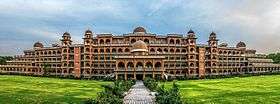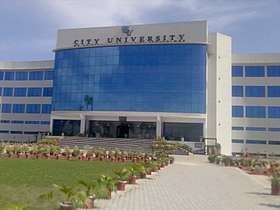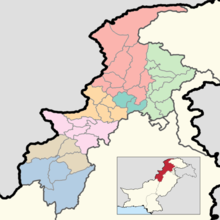Peshawar District
Peshawar District (Pashto: پيښور ولسوالۍ, Hindko: ضِلع پِشور, Urdu: ضِلع پِشاور) is a district in Peshawar Division of Khyber Pakhtunkhwa province in Pakistan. It is located about 160 km west of the Pakistan's capital Islamabad. The district headquarter is Peshawar, which is also the capital of Khyber Paktunkhwa.[2]
Peshawar ضلع پشاور | |
|---|---|
 | |
| Country | |
| Province | |
| Capital | Peshawar |
| Area | |
| • District | 1,257 km2 (485 sq mi) |
| Population | |
| • District | 4,269,079 |
| • Density | 3,400/km2 (8,800/sq mi) |
| • Urban | 1,970,042 |
| • Rural | 2,299,037 |
| Time zone | UTC+5 (PKT) |
| Languages | Pashto, Hindko |
| Website | Official Website |
Overview and History
Peshawar is located in Geo-strategically important location and has an enriched history. This district and city has seen the rise and fall of many civilisations. It was once the centre of Gandhara civilisation and has subsequently been ruled by Persians, Greeks, Buddhists, Kushans, Afghans, Mughals, Marathas, Sikhs and the British. The original district of Peshawar was a district of the North-West Frontier Province of British India.[3]
After independence in 1947, the old Peshawar District became Peshawar Division containing the current districts of Peshawar District, Charsadda District and Nowshera District. In July 1988, the former Charsadda tehsil was separated and became Charsadda District while former Nowshera tehsil became Nowshera District in 1990.[4] Under the latest revision of Pakistan's administrative structure, promulgated in 2001, Peshawar was also given the status of a city district.
Demographics
The population of Peshawar district, according to the 2017 census, is 4,269,079.[5] The population of the district over the years is shown in the table below.[6][1][7]
| Census Year | Population | Rural | Urban | Cantonment Area |
|---|---|---|---|---|
| 1951 | 390,687 | 239,252 | 109,510 | 41,925 |
| 1961 | 529,158 | 310,467 | 171,766 | 46,925 |
| 1972 | 807,012 | 534,315 | 229,223 | 43,474 |
| 1981 | 1,113,303 | 547,055 | 506,896 | 59,352 |
| 1998 | 2,026,851 | 1,044,035 | 914,076 | 68,740 |
| 2017 | 4,269,079 | 2,299,037 | 1,970,042 | 70,741 |
1998 Census
In 1998, the population of the district was 2,026,851, of which 49% were urban.[6] In the 1998 census results for the district, Pashto was the first language of 86% of the population.[8]
1981 Census
According to the 1981 census results for Peshawar tehsil, Pashto was the first language in 80% of households, Hindko – in 13%, Urdu – in 3.8% and Punjabi – in 3.3%.[9]
1897 Records
According to 1897 records during British Raj, most people living in Peshawar valley were Pathans and belonged to an agriculture community but there was also an admixture of Punjabi community living in the valley religiously belonging to both Islam and Hinduism. Most people in Peshawar city spoke and understood Urdu. Elite belonging to small towns such as big feudal Khan families, traders and almost all of Hindus also spoke Urdu. Persian was also spoken by elites of Peshawar city and by traders from Kabul. Majority of the population of the district especially the agriculturists and Pathans only spoke Pashto. 92% of the total population of Peshawar valley practiced religion of Islam and remainder 8% practiced Hinduism, Sikhism and other religions. People belonging to these minority religions only lived in major cities such as Peshawar, Charsadda (now in Charsadda District) and Hoti (now in Mardan District) and mostly in cantonment areas of these cities. 97% of the population living in rural towns practiced Islam.[10]
Education

Peshawar district is the home of excellent education institutes both in public and private sectors. It has universities for all major disciplines starting from Humanities, General Sciences, Sciences, Engineering Sciences, Medical Sciences, Agriculture Sciences and Management Sciences. Currently, there are 9 Medical Colleges of which 2 in public sector and 7 in private sector, which are recognised and approved by Pakistan medical and dental association[11] plus a medical university, Khyber Medical University in the district.
The first public sector university University of Peshawar[12] was established in 1950. In 1980, University of Engineering and Technology, Peshawar[13] was established while University of Agriculture, Peshawar[14] was inaugurated in 1981. The first private sector university CECOS University of IT and Emerging Sciences[15] started working in 1986. In 1995, a public sector management institute named as Institute of Management Sciences[16] was established, which became degree awarding institute in 2005.
In 2001, four (4) new private sector universities started working in Peshawar. The name of these universities are Qurtuba University,[17] Sarhad University of Science and IT,[18] Fast University, Peshawar Campus[19] and City University of Science and IT.[20] Gandhara University[21] was established in 2002 while Abasyn University[22] was created in 2007.

In 2007, Government of Khyber Pakhtunkhwa established first public sector medical university, Khyber Medical University[23][24] and the district also has 2 public sector medical colleges, one is Khyber Medical College[24] and one for girls named as Khyber Girls Medical College.[11]
The first women university was established in 2012, when Shaheed Benazir Bhutto Women University[25] started working while private sector IQRA National University[26] was also established in 2012.
Apart from excellent range of universities, Peshawar district also has huge numbers of further education (Post School) institutes both in public and private sectors. The most renowned are Islamia College Peshawar, which was established in 1913 and was upgraded to become university in 2008 and Edwardes College Peshawar, which is the oldest of all institutions in the district started functioning in 1900.
State of Education in Peshawar
According to Pakistan District Education Rankings 2017 published by Alif Ailaan, Peshawar ranks 4th in Pakistan in terms of primary school infrastructure while it ranks 52nd in Pakistan for middle school infrastructure. In terms of education score, Peshawar ranks 64th in Pakistan with having a relatively low retention score. Beyond Primary Readiness in Peshawar is on the lower side as it ranks 62nd in Pakistan.
The main issues reported in Taleem Do! App for district Peshawar are overcrowded class rooms and lack of class rooms in schools.
Girls’ education is also one of the most reported issues in the app, with main focus on lesser number of Girls schools and also schools located at long distances.
Issues of lack of teachers, non-availability of science labs and lack of High Schools were also reported.
Issues regarding the high fee collections in private schools was also reported on multiple occasions.
Administration
There is only one tehsil in the district which is named as Peshawar Tehsil. The district is divided into 4 towns, 279 mouzas (Revenue Villages), out of which 236 are rural, 15 are urban and 28 mouzas are partly urban. There are 30 police stations in the district.
Provincial Assembly Seats
The district is represented in the provincial assembly by eleven elected MPAs who represent the following constituencies:[27][28]
|
|
National Assembly Seats
The district is represented in the Pakistan National Assembly by four (4) members.[27]
|
|
See also
References
- "DISTRICT AND TEHSIL LEVEL POPULATION SUMMARY WITH REGION BREAKUP: KHYBER PAKHTUNKHWA" (PDF). Pakistan Bureau of Statistics. 2018-01-03. Archived from the original (PDF) on 2018-04-24. Retrieved 2018-04-23.
- "District Health Profile Peshawar District (PDF)" (PDF). paiman.jsi.com. Retrieved 2017-12-20.
- Peshawār District - Imperial Gazetteer of India, v. 20, p. 111.
- District census report of Nowshera 1998, p. 1.
- "Pakistan Tehsil Wise Census 2017 [PDF]" (PDF). www.pbscensus.gov.pk. Archived from the original (PDF) on 2017-11-07. Retrieved 2017-11-29.
- "AREA & POPULATION OF ADMINISTRATIVE UNITS BY RURAL/URBAN: 1951-1998 CENSUSES (PDF)" (PDF). www.pbs.gov.pk. Pakistan Bureau of Statistics. Archived from the original (PDF) on 2018-06-26. Retrieved 24 November 2017.
- "POPULATION AND HOUSEHOLD DETAIL FROM BLOCK TO DISTRICT LEVEL: KHYBER PAKHTUNKHWA (PESHAWAR DISTRICT)" (PDF). www.pbscensus.gov.pk. Pakistan Bureau of Statistics. 2018-01-03. Archived from the original (PDF) on 2018-06-26. Retrieved 2018-04-23.
- District census report of Peshawar 1998, p. 30.
- District census report of Peshawar 1981, p. 87.
- Church Missionary Society (1897). The Church Missionary Review, Volume 48. Cornell University. p. 757. ISBN 0815797613.
- Council, Pakistan Medical & Dental. "Pakistan Medical & Dental Council > About Us > Recognized Medical/Dental Colleges". www.pmdc.org.pk. Archived from the original on 2012-01-16. Retrieved 2017-12-09.
- UoP, CITS. "University of Peshawar". University of Peshawar. Retrieved 2017-12-04.
- "University of Engineering & Technology, Peshawar, Pakistan". www.uetpeshawar.edu.pk. Retrieved 2017-12-04.
- "The University of Agriculture, Peshawar-Pakistan". www.aup.edu.pk. Retrieved 2017-12-04.
- "CECOS – University of Information Technology and Emerging Sciences". www.cecos.edu.pk. Retrieved 2017-12-04.
- "IMSciences". www.imsciences.edu.pk. Retrieved 2017-12-08.
- "Qurtuba University Peshawar". www.qurtuba.edu.pk. Retrieved 2017-12-08.
- "Sarhad University". www.suit.edu.pk. Retrieved 2017-12-08.
- "FAST-NUCES Peshawar | National University of Computer and Emerging Sciences". pwr.nu.edu.pk. Retrieved 2017-12-08.
- "CUSIT: City University of Science and Information Technology, Peshawar". www.cityuniversity.edu.pk. Retrieved 2017-12-08.
- "Gandhara University Peshawar Pakistan: Home Page". www.gandhara.edu.pk. Retrieved 2017-12-08.
- "Abasyn University". abasyn.edu.pk. Retrieved 2017-12-08.
- "Khyber Medical University | Committed to Excellence in Medical Education and Research". www.kmu.edu.pk. Retrieved 2017-12-09.
- Newspaper, From the (2011-09-21). "University status for Khyber Medical College planned". DAWN.COM. Retrieved 2017-12-12.
- SBBWU, ITC. "Shaheed Benazir Bhutto Women University Peshawar". www.sbbwu.edu.pk. Retrieved 2017-12-09.
- "IQRA NAtional University | Peshawar, Hayatabad". www.inu.edu.pk. Retrieved 2017-12-09.
- Report, Bureau (2002-08-09). "PESHAWAR: Peshawar gets 4 NA, 11 PA seats". DAWN.COM. Retrieved 2017-11-30.
- Constituencies and MPAs - Website of the Provincial Assembly of the NWFP Archived 2008-09-17 at the Wayback Machine
Bibliography
- 1981 District census report of Peshawar. District census Report. 26. Islamabad: Population Census Organization, Statistics Division, Government of Pakistan. 1983. p. 86.
- 1998 District census report of Charsadda. Census publication. 68. Islamabad: Population Census Organization, Statistics Division, Government of Pakistan. 2000.
- 1998 District census report of Nowshera. Census publication. 55. Islamabad: Population Census Organization, Statistics Division, Government of Pakistan. 1999.
- 1998 District census report of Peshawar. Census publication. 33. Islamabad: Population Census Organization, Statistics Division, Government of Pakistan. 1999.

